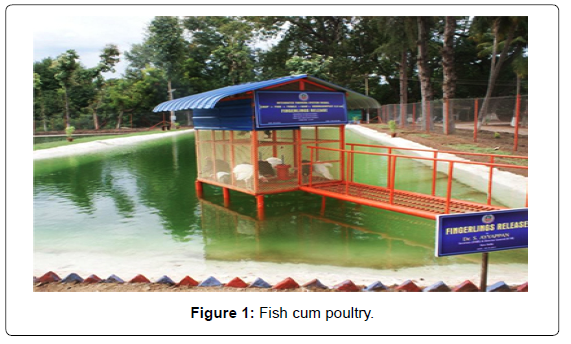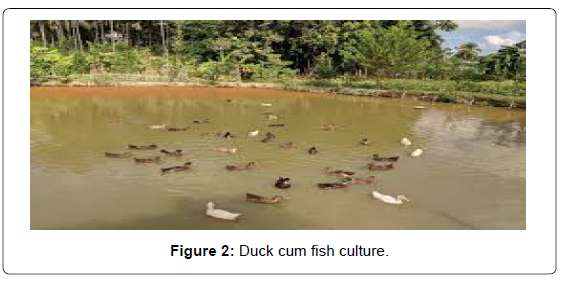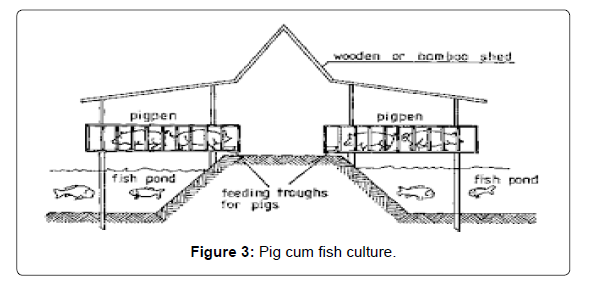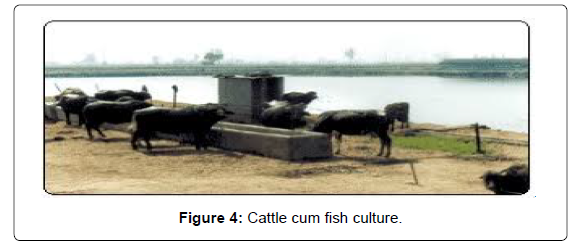Integrated Aquaculture with Special Reference to Fish Integration with Animal Husbandry to Enhance Production and Productivity
Received: 28-Jun-2021 / Accepted Date: 22-Jul-2021 / Published Date: 29-Jul-2021 DOI: 10.4172/2332-2608.1000306
Abstract
Due to an increase in population, Integrated fish farming with animal husbandry is a key player in enhancing higher fish production. This paper reviews on the integrated aquaculture with special reference to fish integration with animal husbandry to enhance production and productivity. Seven common systems of integrated fish farming with animal husbandry were identified; fish cum Poultry, fish cum piggery, fish cum duck, fish cum ruminants, fish cum goat, fish cum rabbit and fish cum cattle. While the common species of fish for integrations are common carp (Cyprinus carpio), tilapia (Oreochromis nilotics), silver carp (Hypophatalmichthys molitrix), catla (Catla catla), rohu (Labeo rohita) and mrigal (Cirrhinus mirgala). Integrated fish farming with animal husbandry has potentials of job creation, improve productivity and it is highly profitable.
Keywords: Animal husbandry, Fish, Integrated, Poultry, Production
Keywords
Animal husbandry; Fish; Integrated; Poultry; Production
Introduction
Integration occurs when outputs (usually by-products) of one production sub-system are used as inputs by another, within the farm unit. According to integrated farming system is mixed farming systems that consist of at least two separates but logically interdependent parts of a fish and livestock enterprises. Integrated farming system as a component of farming systems which takes into account the concepts of minimizing risk, increasing production and profits whilst improving the utilization of organic wastes. Based on experiences from India, described these systems as a mixed animal crop system where the animal component is often raised on agricultural waste products while the animal is used to cultivate the soil and provide manure to be used as fertilizer and fuel [1].
Integrated fish farming system is a type of farming practices in different forms mostly in the East and South East Asian countries is one of the important ecological balanced sustainable technologies. The technology involves a combination of fish polyculture integrated with livestock production. On farm waste recycling, an important component of integrated fish farming is highly advantageous to the farmers as it improves the economy of production and decrease the adverse environmental impact of farming.
Integrated farming involving fish is the concurrent or sequential linkage between two or more human activity systems, of which at least one is aquaculture. Furthermore, the linkages between aquaculture and human activities involves agriculture (i.e., crops, livestock, irrigation dams’ canals), sanitation (nightsoil, septage or other forms of human excreta re-use, sewage treatment), nutrient recovery (hydroponic— fish, breweries) and energy recovery (culture in heated effluents of power plants, dairies, etc.)
The integration of aquaculture with livestock provides quality protein food, resource utilisation, recycling of farm waste, employment generation and economic development. Integrated aquaculture system is implemented in different parts of the world and it has very long history with an aim of improving fish production, minimizing fish production costs, environmental protection from pollution and waste management and increasing income, generating fish feed from waste materials. Integrated fish farming is well developed culture practice in China followed by Hungary, Germany and Malaysia. The integrated fish farming is accepted as a sustainable form of aquaculture [2].
Integrated aquaculture production system is not well developed in Africa. Egypt was the starter of traditional aquaculture production system while the modern one was started in Kenya. Some progress on integrated aquaculture agriculture systems has been reported in a few African countries such as vegetable fish farming in Ghana and Malawi in east Africa fish farming is practiced for nutritional needs and to some extent for income generation.
Basic principles of integrated fish farming with animal husbandry
Integrated fish farming with animal husbandry is based on the concept that ‘there is no waste’, and waste is only a misplaced resource which can become a valuable material for another product. In integrated farming, the basic principles involve the utilization of the synergetic effects of inter-related farm activities and the conservation, including the full utilization of animal wastes [3].
Productivity of integrated fish farming with animal husbandry
The biological productivity of any aquatic body is generally judged through the qualitative and quantitative estimation of planktons, which form the natural food of fish. Animal wastes lead to increased biological productivity of ponds through various path-ways, which result in increase in fish production. Productive capacity refers to the biomass produced in kg/ha, thereby measuring “net community production” of the system. This capacity reflects the quality of the underlying soil and the quality of the pond water; it also depends on the nature of the manure involved. According to the nature of manure affects the community structure of plankton. In a given ecosystem the ratio of biomass supported per unit of energy flow determines how mature the system is this reflects the ability of the system to convert available energy into something useful [4].
Fish species for integrated livestock-fish farming
The most suitable species of fishes for integrated livestock-fish farming are those fishes that can filter and feed on phytoplankton, zooplankton and bacteria from water. The objective of integrated livestock cum fish farming is to produce maximum plankton in water through manuring which is rich in protein and a natural feed for fishes. The species of fishes which are consumed by the people and are efficient utilizer of Phyto and zooplankton and also with macrophyte feeding nature are excellent for integrated livestock fish culture. Depending on the feeding nature the fishes are divided into three categories viz. Surface feeder, Column feeder and Bottom feeder.
In integrated system of fish species for farming are Catla (Catla catla) which are zooplankton feeder and exotic species Silver carp (Hypophthalmichthys molitrix) which are phytoplankton consumer are best example of surface feeder, whereas Rohu (Labio rohita) is omnivorous in nature and column feeder. The Mrigal (Cirrhinus mrigala), and Kalabasu (Labeo calbasu) are detritivores and common carp (Cyprinus carpio) which are detritivorous/ omnivorous in nature are bottom feeder. species like Grass carp (Ctenopharyngodon idella) which are herbivorous cover surface, column and marginal area of feeding zone and tilapia(Oreochromis niloticus) are the common fish species cultivated under integrated fish animal husbandry to enhance productivity [5].
Management of pond in integrated livestock-fish system
The pond should be water retentive and not to be situated in flood prone area. There should be constant water supply or throughout the year there should be water in the pond. Seasonal ponds, which can retain 8-to-9-month water also, can be considered for integrated farming system. At least there should be 1.0 m of water and ideal is 1.5 to 3.0 m. Soil pH should be within the range of 6.5 to 7.5. If the soil pH is not up to the desired level, the pH may be corrected by application of lime and the quantity of lime is 2000 kg/ha for 4.0 to 5.0 pH, 1200 kg for 5.1 to 6.0, 1000 kg for 6.1 to 6.5 (mild acidic), 400kg for 6.6 to 7.0 (more or less neutral) and 200kg/ ha for pH 7.1 to 7.5, which is mildly alkaline.
Lime helps in maintaining pH, kills and decomposes parasites. The lime should be applied in 3 to 4 split doses. The basal dose of lime and cow dung application in per hectare of water bodies is 1200 kg and 5000 kg, respectively. The pond should be regularly cleaned from aquatic plants which prevents sunlight penetration and oxygen circulation in water as well as shelter fish predators. The weeding can be done by manually, mechanically, biologically, chemically or by increasing the water depth in the pond. To kill predatory fishes Mahua (Bassicala tifolia) may be applied at the rate of 2500 kg/ha of water bodies. By repeated netting unwanted fishes may also be removed. The ammonia, tea seed cake and bleaching powder also can be applied to remove enemy fishes [6].
Systems of integrated fish farming with animal husbandry
The common systems of livestock-fish farming include cattle-fish system, pig-fish system, poultry-fish system and duck-fish system.
Poultry-fish systems
This system utilizes Poultry dropping of fully built-up poultry litter for fish culture. Poultry-fish farming is the integration of poultry, such as chickens, ducks and geese with fish farming. The poultry house can be constructed over the pond or adjacent to the pond. In both cases the excreta from the birds can serve as feed, which fertilizes the pond or the fish can feed on the excreta directly. The use of poultry in an integrated production system with fish has several benefits such as low digestibility due to the size of digestive tract resulting in nutrient rich manure and subsequent low input integration, as well as the apparent synergistic relationship between the two production systems under integration. Poultry waste contains less moisture, fiber and compound such as tannins that discolors water when used as fish pond fertilizers [7].
They had considered poultry manure to be a complete fertilizer with the characteristics of both organic and inorganic fertilizer by using poultry manure they obtained a fish yield of 670 kg/ha in three months without supplementary feeding. Each bird produced approximately 40g of manure daily. It was reported that the excreta of 250-300 egg laying hens and 150-200 broilers produced four tons and 3-4 tons of fish/year respectively when recycled in a 1ha pond. Poultry manure like other organic waste can convert crud inedible materials in to high quality fish feed. They can increase microbial activity in the water column and at the pond bottom by releasing the nutrients and minerals originally bound and can provide the substrates for photosynthetic productions of basic fish food.
Fresh chicken manure contains 1.6% nitrogen, 1.5% phosphorus and 0.9% potassium. Furthermore, its total protein is as high as 20- 30%. About 0% of the poultry manure represents undigested food stuffs (25% dry matter) due to the very short digestive tract of chickens [8].
Total net fish productivity of 4,462.6 kg/ha/year was obtained at a stocking density of 20,000 fingerlings of Clarius batrachus per hectare by providing dry poultry sweeping at a rate of 90 kg/ha/day. It was reported that ponds fertilized with poultry manure showed the highest fish production 2,663.50 kg/ha/year when compared with pig and cow manure Figure 1.
Duck-cum-fish culture
The duck is commonly called as biologicals aerator. They are reared on the dyke of the pond in a low-cost house. This farming is practised in India. The duck not only act as live aerator by splashing water with their webbed feet but also control the aquatic weed, aquatic insects, molluscs and tadpoles. The duck droppings are used as manure for primary production [9].
The optimum number of ducks for optimum manuring of a fish pond will depend on the natural fertility of soil and water of the pond. They reported that 300-500 ducks/ha gave fish yield of 500- 800 kg/ha in 150 days in Hungary where silver carp, common carp and bighead carp were cultured. In Vietnam, rearing 1,000-2,000 ducks/ha on ponds increased the average fish yield to as much as 5,000 kg/ha/yr, compared to 1,000 kg/ha/yr. without ducks; but he did not mention the fish species cultured. However, in contrast, reported that ponds with ducks at a density of 1,250/ha gave lower fish yields than those with 750 ducks/ha. This reduction in fish yield might have been associated with over manuring of the ponds.
An excessive amount of duck manure in ponds might also be responsible for fish death. They reported fish kills in ponds during summer where more than 3,000 ducks/ha were kept in Hong Kong. In integrated duck-cum-fish farming, different duck densities have been recommended by different authors. It has been indicated the optimum duck density of 2,500-3,500/ha in Hong Kong fish ponds. From India, they had suggested 100-150 ducks can provide adequate fertilization of one hectare of water.
A combination of six species viz, Catla (20%), Silver carp (20%), Rohu (20%), Mrigal (15%), Grass carp (10%) and Common carp (15%) should be stocked at density of 8000 to 8500 fingerlings/ha for the targeted production level of more than 3500 kg/ha. Such integration is suitable only for rearing and stocking ponds where fishes are above 12 gm Figure 2.
The technology of integrated fish/duck farming can increase average fish production from 200-500 kg/hectare to 1,000-4,000 kg/hectare from seasonal and perennial ponds. In panama, fish production was 3,460 kg/ha/year in three duck/fish combination compared with 2,329 kg/ha/year in a fish poultry system. By this integration a production of 3500-4000 kg of fish, 18000-18500 eggs and 500-600 kg duck meat from 1 ha of pond area in 1 year without any supplementary feed and fertilizers can be obtained and the cost is turned down to 60% lesser than normal [10].
Pig-cum-fish culture
In integrated fish farming with pig, the ‘pig dung’ is useful for conditioning the soil and providing the necessary nutrients required for fertilizing the pond water. Fish-cum-pig culture is practiced at large in China where pigs are considered as “costless fertilizer factories”. It has been reported that in Hong Kong and philipines, 100 pigs weighting 30 kg each were considered adequate to fertilize and maximize total revenue from a 1ha fish pond. Total fish production of about 6.8 tons/ ha/year was obtained though fish pig integrated farming system with stocking density of 80 pigs and 20,000 fish fingerlings/ha of water shad. The application of pig manure at a rate of 31.25 kg/day did not result in dissolved oxygen levels below 3mg/l. A net yield of 2.4 tons/ha/year was obtained by using 1,080-meter cubed liquid pig manure Figure 3.
In Thailand the production of five tons of tilapia annually was obtained by integrating 150 pigs/ha of pond. Each pig excretes a total of feces and 1.2 ton of urine (wet weight basis) during rearing piglet to adult over a period of eight months. In India a total of fish production of 2,219 kg/ha/year was obtained in a pig manured pond. About 35-40 pigs would be sufficient to fertilize 1 hectare of water, fish production in pig/fish farming operations ranges from approximately 2,000-5,000kg/ ha in six months [11].
Cattle-cum-fish culture
Cattle wastes and washings from the cattle sheds are conveyed through pipes into the ponds which acts as good fertilizer. Cattle wastes are generally collected in a pit for later use. In addition to fish yield, production of milk from cattle and beef adds to the economy. The cattle urine, washings and manure can be used as fertilizer for fish ponds. They reported that daily liquid cow manure application without supplementary feeding resulted in remarkably high fish productivity of 32.7 and 31.5 kg/ha/day at stocking density of 17,980 and 9,240/ha. He also reported that a fish food conversion ratio on liquid cow manure on dry matter basis was 2.7 (a quantity of 22.6-liter cow manure equals 12% dry weight).
According to per day total wet waste of cattle amounts to 9.4% of total live weight the metabolizable energy available in cow manure ranged between 600 and 800 kilo cl/kg. It was demonstrated that a similar productivity level in ponds that individually received organic fertilizers at a rate of 70 kg single superphosphate and 70 kg of ammonium phosphate/ha fortnightly and cow manure at a rat of 100 kg of dry matter/ha/day. They recorded fish production of 789 kg/ha/ year from ponds that received cattle manure [12].
It is a common practice all-over the world. The cow excreta are most abundant in terms of availability and a healthy cow may excrete over 4000-5000 kg dung and 3500-4000 litre urine on an annual basis. The BOD of cow manure is lower than other livestock manure. About 5-6 cows can provide adequate manure for 1 ha pond in addition to 9000 kg milk and about 3000-4000 kg of fish annually. Cow-shed should be built close to fish pond to simplify handling of cow-manure Figure 4.
Health issues related to integrated farming with animal husbandry
The possibility of circulation of other sewage bacteria and potential or opportunistic bacteria becomes more apt in integrated farming system model because of closely knit livestock, fishery and human components. Integrated farming may result in origin of new pathogens or re-assortment of older ones into new forms. These are not merely fearing but a few diseases are common in areas where integrated farming systems are more prevalent. Influenza pandemic possibly originated from pig-duck agriculture, facilitating, reassortment of avian and mammalian influenza viruses [13].
Japanese B encephalitis, malaria, dengue and yellow fever infections may spread widely from integrated faring system hubs because integrated farming system provide good breeding ground to mosquitoes, the vector for the infections. It is well known that pigs and other animals under such integrated intensive farming management may become carriers of methicillin-resistant Staphylococcus aureus and other dangerous pathogens due to many reasons, posing a serious health threat to the community. Ducks raised in association with fish farms and the use of chicken dung as fertilizer in fish farms may contribute to the spread of diseases, such as highly pathogenic avian influenza, but in this case the ducks are the vector not the fish [14].
Importance of integrated fish farming system with animal husbandry
The main advantages of integrated fish farming are efficient waste utilisation from different culture practice for fish production, It reduces the additional cost for supplementary feeding as well as fertilisation, It is an artificial balanced ecosystem where there is no waste, It provides more employment avenues, It reduces the input and increases output and economic efficiency, The integrated fish farming provides fish along with meat (chicken, duck, beef, pork etc.) milk, vegetables, fruits, eggs, grains, fodder, mushroom, has potential to increase the production and socio-economic status of weaker section of our society, Full utilization of farm wastes, Utilization of the cooperative effects of inter-related farm activities, increases nutritional source for the farmer’s family, gives higher and stable farm productivity and there is less risk (biologically and economically) increases the income of rural population, is a means of land reclamation in certain areas and It is an efficient and economic means of environmental management [15].
Conclusion
Integrated fish farming with animal husbandry is a combination of fish culture alongside with Poultry, Piggery, duck production etc. This type of farming offers great efficiency in resource utilization, as waste or by-product from one system is effectively recycled. It also enables effective utilization of available farming space for maximizing production. Integrated fish farming has potential to increase the production and socio-economic status of a society. It contributes immensely to the economic empowerment of many families especially in the rural communities. It reduces the input and increases output and economic efficiency. The economic benefit of integrated fish farming cannot be over-emphasized since the integration is varied and diversified in nature. It is one of the most viable, reliable and profitable of any farming enterprise. It reduces the additional cost for supplementary feeding as well as fertilization. Manure loading in integrated fish farming basically comes from poultry and other farm animals, which contain considerable quantities of nutrients for fish production. It also contains non digested feed. It can be utilized to replace reasonable parts of feed stuff used in conventional fish production cost.
References
- Athithans, Francis S, Ramanthan S, Ramandas U (2001) Cattle urine as a benefitting source of nutrients for production. J Indian Fish 48: 231-235.
- Banerjee RK, Sing GS and Dutta BR (1979) Poultry droppings and its manurial potentiality in aquaculture. J Inland Fisheries Soc 2: 94-108.
- Dalsgaard JPT, Light foot C, Christensen V (1995) Towards quantification of ecological sustainability in farming systems analysis. Ecol Eng 4: 181-189.
- Fagberno OA, Sydenham DH (1988) Evaluation of Clarias isheriensis (Sydenham) under semi-intensive management in ponds. Aquaculture 74: 287-291.
- Francis T, Pandurengan P (2004) Review on integrated fish farming. World Aquculture 35.
- Hatch U, Engle C (1987) Economic analysis of aquaculture as a component of integrated Agro aquaculture system, science evidence from panama. J Aquaculture Tropics 2: 93-105.
- Hopkins KD (1982) Outstanding yields a profits from livestock tilapia integrated farming. ICLARM Newsletter 5: 13.
- Jayanthi C, Rangasamy A, Chinnusamy C (2000) Water budgeting for components in lowland integrated farming systems, Agri J 87: 411- 414.
- Moav R, Wohlfarth G, Schroeder G (1977) Intensive poly culture of fish in fresh water ponds. I. substitution of extensive feeds by liquid cow manure. Aquaculture 10: 25-43.
- Odum HT (1989) Self-organization transformation and information: Ecol Sci 242: 171-181.
- Ofori J, Prein M, Fermin F, Owusu D, Lightfoot C (1993) Farmers picture new activities: Ghanaian farmers gain insight in resource flows. ILELA Newsletter 9: 6-7.
- Oribhabor BJ, Ansa EJ (2006) Organic waste reclamation, recycling and re-use in integrated fish farming in the Niger Delta. J Appl Sci Environ Mgt 10: 47-53.
- Prein M (2002) Integration of aquaculture into crop-animal systems in Asia. Agr Syst 71: 127-146.
- Radhammani S, Balasubramanian A, Ramamoorthy K, Geethalakshmi V (2003) Sustainable integrated farming systems for dry lands: A review. Agri Rev 24: 204-210.
Citation: Gebru T (2021) Integrated Aquaculture with Special Reference to Fish Integration with Animal Husbandry to Enhance Production and Productivity. J Fisheries Livest Prod 9: 306. DOI: 10.4172/2332-2608.1000306
Copyright: ©2021 Gebru T. This is an open-access article distributed under the terms of the Creative Commons Attribution License, which permits unrestricted use, distribution, and reproduction in any medium, provided the original author and source are credited.
Share This Article
Recommended Journals
Open Access Journals
Article Tools
Article Usage
- Total views: 2935
- [From(publication date): 0-2021 - Mar 29, 2025]
- Breakdown by view type
- HTML page views: 2186
- PDF downloads: 749




